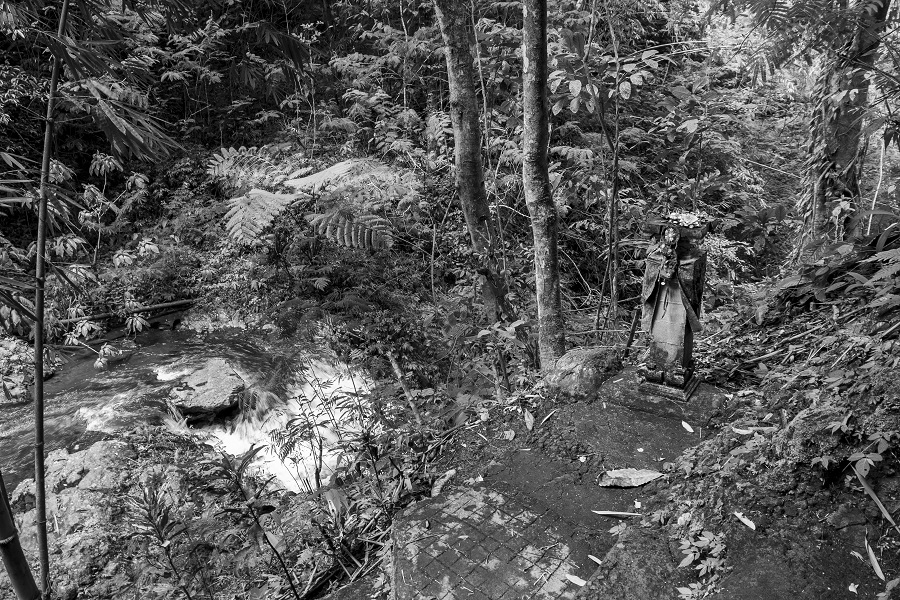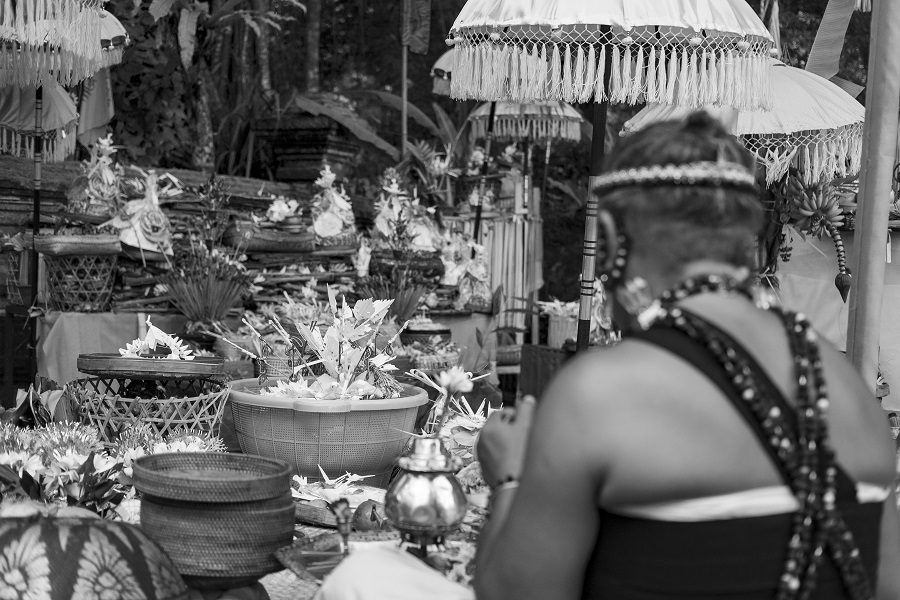
People have misconceptions about Balinese religion. Many see it as strictly Hindu. It may be so in children’s school books, which emphasises classical Hindu-Indian cosmology, but this is a “fundamentalist” evolution. The Balinese may refer once in a while to Hindu gods, but the daily ritual life is dominated by the worship of ancestors of many variants, as illustrated below.
I like to talk to my friend Made Kamajaya. Sometimes he visits me and, around a cup of coffee, we discuss this, that and other things. The other day, as we were talking about crime in Jakarta, he suddenly exclaimed: “We are not like this in Bali. We are afraid of killing people”. “Come on, Made,” I retorted. “You know better than me what happened on this island 60 years ago,” I reminded him, referring to the ‘hushed’ culling of communists back in the mid-60s. “Precisely that!” He replied. “We don’t like to kill because we may have to worship the person we have killed. A sort of karma haunts us.”
It was suddenly becoming interesting. I asked him to explain.
“It happened in my village of Abian Tuwung, in the Busung Biu area. It was perhaps one hundred years ago, because my parents still knew the name of the woman who was at the origin of the murder. It was Kerti, the flower of the village, and the murderer was my own grand father, Pan Lutung. He was very much in love with her. But she spurned him. This made him madly jealous, especially since he had been told he was not the only suitor. There was another guy on the prowl. So, he kept watch on all she was doing. He spied on her, desperate to know who his rival was. This went on for months, until on a given day, as she was washing clothes at a nearby stream, a young fellow happened to pass nearby on some errand, or perhaps in search of work on the plantations. He saw the beautiful Kerti, said a few words to her and continued on his way. Seeing this, my grandad’s obsessions turned into paranoid suspicions. He lost his wits. He followed the young man, caught up to him and before the unwary wanderer could even gather what was happening, his throat had be slit by a machete! Before fully passing, he looked up at his killer and said straight into his eyes: “You may have killed me, whoever you are, but you will now end up worshipping me….” Then he closed his eyes forever, the oozing blood flowing and staining the nearby stream.” That was Made Kamajaya’s story to me.
It was a crime of course. But Lutung, his grandpa, was never caught. For weeks, no one was even aware that a crime had taken place. The murdered young man was from another village. His co-villagers were not even aware of his demise, thinking that he had simply resettled. Yet, after a few weeks, even though the corpse was not visible, the stench could not be hidden. The corpse was thus discovered. Who was this poor soul, so brutally murdered and discarded? No one knew. So he was taken to the village cemetery, and simply buried there, entrusted to Mother Earth. A big Rsi Gana Caru ceremony was performed to cleanse the village from the impurities brought about by death.
It should have settled the whole thing, but it didn’t. Why? Because – at least in the eyes of my Balinese friend — the burial and the ritual caru exorcism did not address the right thing. It cleansed the land, perhaps, but did not appease the soul of the murdered man, which had become a lost soul (atma kesasar) and thus could not find its way back to the ancestors’ abode, above the mountain. It erred around the village and even beyond. According to my friend Made, the exorcism had also missed something, which no one was aware of: the blood of the murdered man had besmirched not only the village, but all the irrigation canals and rivulets downstream. Impurity (cuntaka) thus hung over the whole area down to the Bali sea.
Of course such impurity had its consequences. In the course of time, illnesses became more numerous, accidents more frequent, or so it seemed. People in the villages downstream started feeling that something was amiss. Some conducted more big caru exorcisms, others visited the mediums, the balian shamans who could speak to the other side, for answers, but it was to no avail. Instead there were new illnesses and accidents coming up. And it lasted for years, ten or fifteen, according to my friend.
Until Putung’s brother was also hit: he broke his leg and could not work. What to do? There was an old balian (shaman) in Busung Biu; Putung’s father decided to visit him to know what was going on. He would ‘ask for words’ (nunas baos). The balian would tell what was to be done.

The old balian had indeed much to say, especially, having inhaled his pasepan fumes, when he was taken over, in a motionless trance, by the lost soul of the dead: “I am shivering of cold”, the latter said amid screams and gurgling. “Please, help me. Build me a proper resting place.”
There was little doubt to have. It was the man who had been murdered and hastily buried years ago. His lost soul was wreaking havoc in the area. What to do? Village elders were consulted. They understood right away: the soul of the dead man wanted a resting place, a shrine. In other words a temple. It was the only way to restore peace and prosperity to the area.
So the villagers did build the requested temple. Meanwhile the word had spread in nearby villages that the cause of illness and other mishaps was now identified. Help thus came from all the villages around. The temple they built was a simple one. It was walled, of course, but consisted of a simple altar to house the murdered man’s soul, now given a name: Dewa Hyang Resi, who had at last found a resting place. Nearby was built a small Ngrurah, to house its guardian.
However, there remained something to do: to find the mangku priest who would look after Hyang Resi’s unruly soul, prepare the temple festivals, and the like. How does one find such a priest? Usually through a jero dasaran (trance dancer), a man used, at the height of the ceremonies, to channel the voice of the gods. He would be the one who would designate the mangku priest.
At the peak of the rite, when the gamelan was reaching its highest pitch, and when the jero dasaran entered into a trance, possessed by Dewa Hyang Resi’s soul, whose name did he say aloud, to designate as his temple’s guardian? You guessed it. The murderer himself: Lutung. Lutung slumped in awe, begging for mercy, and blurting out a confession of his crime. But time had passed. He was never arrested nor judged.
Since then, Lutung, then his younger son and the younger son of his son have all been mangku priests for the temple of Dewa Hyang Resi – the name given to the soul. Its congregation is huge, as villagers from all the villages downstream, the water of which had been besmirched by the murdered man’s blood, have all to attend the ceremonies. At temple festivals, sometimes, a jero dasaran gets into a sudden trance and asks the mangku priest for this or for that: bigger offerings, a new entrance gate to the temple etc. His wishes are immediately fulfilled, so afraid is Made, Made’s family, and all the villagers that the dead man’s soul could bring pestilence to their region.
Made himself told me he was going home in two weeks to pay his respect to the dead man’s soul. He will thus be worshipping, as announced by the curse, the man his great-grand father killed.






